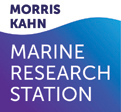Trigons on the BROV
We Are Better Together!
The Morris Kahn Marine Research Station is a long-term ecological research station focused on six main research topics in the eastern Mediterranean basin. Inevitably, projects from different topics often intersect, offering valuable insights to one another. Here’s a great example:
Ole, a PhD student working extensively with BRUV data, is conducting research to model the distribution of various fish species, identifying key spatial drivers of their assemblages. The analysis will extend to pinpointing hotspots of species richness, diversity, and biomass. This comprehensive approach provides nuanced insights into the intricate relationship between habitat characteristics and fish communities.
During his research, Ole’s BRUV captured footage of a guitarfish at a depth of 35 meters, as seen in the video. He was able to assess its total length, which measured 80 cm. Although species identification isn’t conclusive from this short clip, this sighting is valuable to Eynav , a PhD student in the Apex Predators Lab led by Aviad , who focuses on the genetic connectivity and population structure of a specific guitarfish species, Glaucostegus cemiculus, in the eastern Mediterranean basin.
Eynav has taken over the station’s guitarfish project, which was initiated in 2017 by Barak , an MSc graduate. Genetic analyses from 2019 found that guitarfish neonate aggregations along the coastline, characterized as nursery grounds, are exclusively G. cemiculus although another species of guitarfish Rhinobatos rhinobatos is very common in the eastern Mediterranean basin. This may indicate niche partitioning between the two species, with deeper waters being an important site for R. rhinobatos. The partitioning of resources, especially prey, can reduce competition between these sympatric species, enabling co-existence and increasing survival rates during crucial life stages for both.
While this is just a single sighting, the video of an 80 cm-long guitarfish offers a glimpse into the possible dispersal rage of guitarfish during the juvenile stage.
This example is one of the main objectives in creating The Morris Kahn Marine Research station and underscores the importance of interdisciplinary collaboration at the research station. By sharing data from different fields—like Ole’s spatial analysis of fish communities and Eynav’s genetic studies on guitarfish connectivity—researchers can deepen their understanding of complex ecological dynamics. Such collaborations not only enhance individual projects but also contribute to a more holistic understanding of the ecosystem, ultimately advancing marine conservation efforts.

